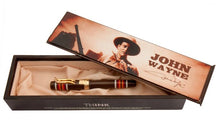"Courage is being scared to death, but saddling up anyway." - John Wayne
Think commemorates John Wayne with this bold rollerball pen - its fine resin barrel is made up of alternating bands in Western palette colors of sand, dark brown, red, rust, and orange. The clip is modeled after the River Waves of the Red River D brand (from the 1948 film Red River). Monument Valley Buttes rise atop the band which features John Wayne’s signature.
Each pen comes in a luxuriously lacquered John Wayne box.
Limited Edition 888 Fountain Pens (Medium nib only) and 888 Rollerballs.
Marion Mitchell Morrison (born Marion Robert Morrison) was born in May 26, 1907 in Winterset, Iowa. He eventually moved to Los Angeles when he was four years old. In Los Angeles, he found himself working in local film studios after he lost his football scholarship to USC after a body surfing accident.
He initially started working for Fox Film Corporation mostly acting in small roles before his big acting breakthrough in the film Stagecoach (1939). Wayne became an instant star and would go on to star in 142 pictures, mostly in western films.
In 1930 director Raoul Walsh was looking for someone to play the leading role in his film The Big Trail. He noticed Morrison moving around studio furniture while working as a cast boy and decided to give him the starring role in his film. For Morris's screen name, Walsh suggested "Anthony Wayne" named after "Mad Anthony Wayne" (a revolutionary war general).
Fox Studios Chief Winfield Sheehan rejected the idea, stating it was "too Italian." Walsh then purposed "John Wayne" and Sheehan agreed, thus John Wayne was created. Wayne was not even present at this meeting.
Wayne played small roles in A-pictures after The Big Trail. He played small roles in the 1933 version of The Three Musketeers and even played as a corpse in the film The Deceiver (1931). He performed these small roles from 1930 to 1939 until his breakthrough. The film Stagecoach was indeed a challenge to become an A-budget film, because of Wayne's non-star status and record for being in low budget films. The director John Ford eventually struck a deal with Walter Wagner and the film became a financial success.
Wayne stared in his first color film two years after Stagecoach with longtime friend Harry Carey. Wayne would go on to star in over twenty of John Ford's films for the next two decades, consisting of She Wore a Yellow Ribbon (1949), The Quiet Man (1952), and The Man Who Shot Liberty Valance (1962).
Later on in his career, Wayne won a Best Actor Oscar for True Grit (1969) and was nominated as the producer for The Alamo (1960). In Wayne's last film, The Shootist (1976), Wayne played an old gunslinger by the name of J.B. Brooks who is dying of cancer. Wayne passed on from stomach cancer three years later.
Several public locations were named after Wayne in his honor such as John Wayne Airport in Orange County, California, John Wayne Elementary School in Brooklyn, New York, and John Wayne Pioneer Trail in the Iron Horse State Park. In June 1999, The American Film Institute named Wayne 13th among the greatest male screen legends of all time.




